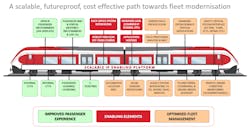Maintenance Benefits of the Networked Train
Jay Saw, Nomad Digital commercial director, recently presented at the Golden Spanners Awards at a meeting of the Modern Railways Fourth Friday Club. His account of the talk is one of optimism and hope for the future in light of the challenges rail operators' budgets currently face.
“It was a privilege but also slightly daunting, talking in front of such experienced rail engineers and maintainers at the recent Golden Spanners Awards. As a digital and telecoms man it’s important I do not preach to the audience, as we have a great deal to learn from interacting with peers who oversee the engineering and maintenance of railway fleets on a daily basis.
My talk was about giving engineers the tools and insight to make significant cost and energy savings across their fleets and thankfully this has real resonance. The current budget for train maintenance in the UK is £2 billion, and the McNulty report set a target to cut costs by 30% five years ago, though we remain a long way off that. However, we believe that significant savings can be achieved in maintenance through the use of ICT and operational technology as part of a digital train philosophy.
In comparison with the airlines and car industry, the rail industry has been slow to adopt this ICT technology: our estimate is that only 10% of trains across the world are truly connected. Too many operators add digital systems in a piecemeal way and one-third of systems experts are expected to leave their company through retirement in 10 years, creating an impending brain drain on the legacy systems which may remain ad-hoc and confusing.
The key to a fully networked, fully-connected train is to start by understanding what information you can get out of it – having a blueprint in mind at the outset is vital. Norwegian operator NSB and others, such as NS, have this vision, yet in the UK it remains to be seen how well we can embrace this philosophy.
The aim of the digital train concept is to give a single maintainer-friendly view of the train. True digitisation involves the ability to predict failures, highlight hidden issues and issue real-time alerts when failures happen. By using information in a more controlled way to plan corrective maintenance, engineers can move towards a condition-based maintenance regime, helping to maximise equipment life, increase availability and reliability and reduce costs. The key is to identify potential failure points before a failure occurs, as the repair cost is usually far lower and to do this, warning signs need to be identified.
But train systems can generate a huge amount of data – a standard EMU gives about 5,000 signals, equivalent to 2GB of data per train per day, and gathering this data is costly – data transmission could cost around £2,000 per train per annum. We think that about 0.25% of this data is critical from a maintenance perspective, and so the secret is smart use of the full data set. This requires the ability to access this data, process it and then have an on-shore back office solution which can visualise and analyse it, develop predictive algorithms and integrate procedures into maintenance management. Data can then be compared to understand how fleets are performing relative to each other and, if presented in a standardised form, allow for direct comparisons across manufacturers.
An example of the success of the digital train concept is its application to the Portuguese Pendolino fleet. Here, 70% of maintenance tasks are now condition-based - in a more controlled and managed environment. This has helped reduce in-service failures by 43%, increase availability by 20%, raise average fleet mileage by one-third and reduce instances of ‘no fault found’ by 40%. Over a 12-year period, maintenance costs have fallen by 57%, demonstrating the significant room for improvement that the digital train concept offers.
There are clear benefits then and I was grateful to Modern Railways to provide me with the opportunity to share these. We think Condition Based Maintenance is hugely powerful. But it is only through the insight and intelligence of the engineers and maintainers that use it, that it becomes most effective."
